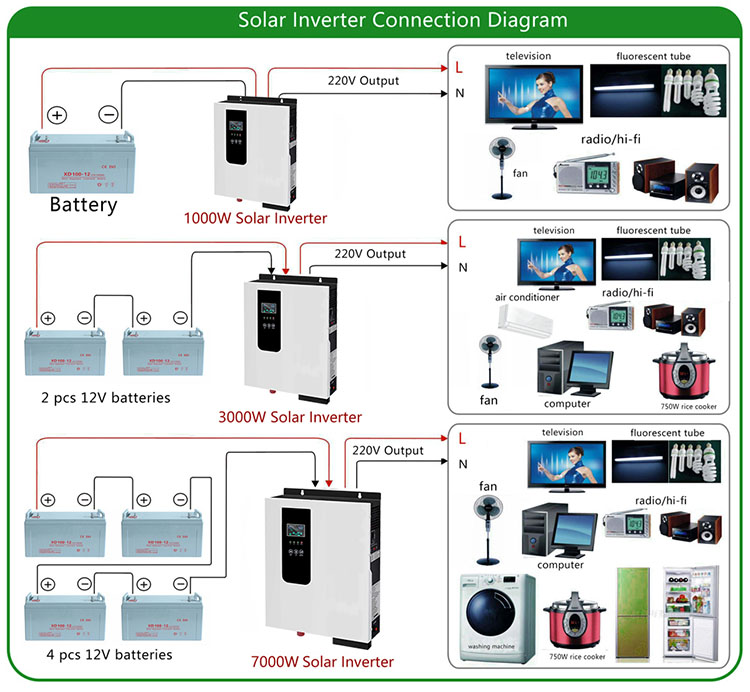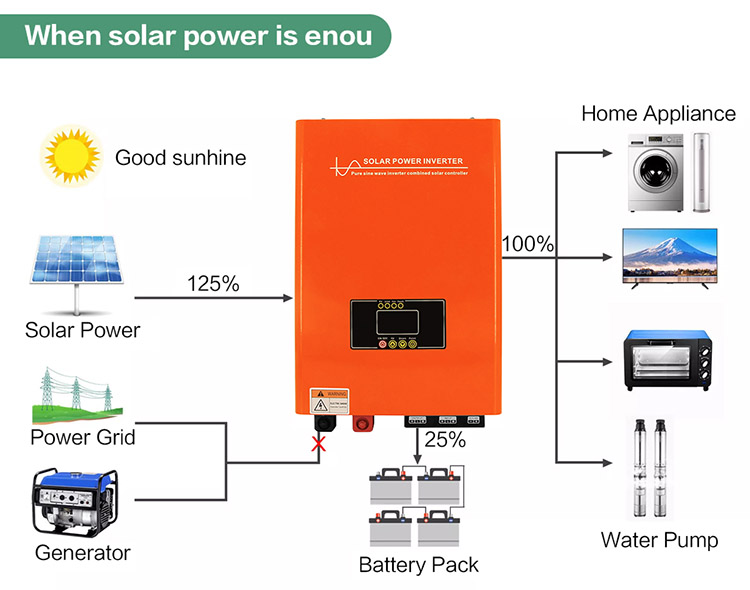What kind of inverter should be selected for household appliances?
 Aug 05,2022
Aug 05,2022

 Rekesun
Rekesun
The home inverter is a converter that converts DC power (battery, storage battery) into constant frequency and constant voltage or frequency modulation and voltage regulation AC power (usually 220V, 50Hz sine wave). It consists of inverter bridge, control logic and filter circuit. Widely used in air-conditioning refrigerators, video recorders, fans, lighting, etc. In foreign countries, due to the high popularity of automobiles, you can use the inverter to connect the battery to drive electrical appliances and various tools to work or travel. The on-board inverter output through the cigarette lighter is 20W, 40W, 80W, 120W to 150W power specifications. Some larger power inverter power supply should be connected to the battery through the connecting wire. Connecting home appliances to the output of the power converter enables a variety of appliances to be used in the car. For pure resistive household appliances such as heating wires, light bulbs, and sun lamps, the power marked on the appliance should be divided by 0.9, for example: 100W bulb, 100 divided by 0.9 =111, so we have a 120W Inverters are safe to use.
The commonly used electrical appliances list the inverter power to be equipped
1. For pure resistive household appliances such as heating wires, light bulbs, and sun lamps, the power marked on the appliance should be divided by 0.9, for example: 100W light bulb, 100 divided by 0.9 =111, so we match A 120W inverter is safe to use.
2. TV, TV is divided into two types, one is LCD, the other is picture tube. For LCD TV, as long as the inverter is 2 times larger than the TV standard power. For example: LCD TV standard 100W, we match The 300W inverter can definitely be used. For the picture tube, because of the large capacitance, the degaussing coil is equivalent to an inductive load, and the impact force is very strong. Generally, it is calculated by 10 times the peak value. For example: 100W, the peak value is 1000W, we need to match 500W The above inverter can be driven.
3. Computer, if it is an LCD monitor, select the LCD TV point plus 90W power (computer host power), if it is a picture tube, calculate its peak power plus 90W according to the nominal power of the selected monitor (the host power is generally 90W If you feel troublesome, just use a 500W inverter directly, there is absolutely no problem.
4. The hand drill is calculated according to 3 times the peak value (the hole will be drilled only when the no-load operation is stable, so the peak value is small), such as: 500W, 1500W peak with 800W inverter, 1500W, with 3000W inverter. Water pump, household 500W, calculated by 7 times (the water is pumped as soon as it starts, the full load starts, and the peak start is large), the peak value is 3500W, it needs to be equipped with an 1800W inverter, and a 750W water pump needs to be equipped with a 2500W inverter to run safely.
5. For air conditioners, the non-inverter inverter is calculated as 7 times the peak value, and the inverter inverter is calculated as 4 times the peak value. For example, 1000W per hour air conditioner, 7 times is 7000W, 3500W inverter peak value is 2 times, just 7000W. Double calculation, the peak value of 1000W is 4000, and the peak value of 2000W inverter is just 4000W, so the inverter also needs 2000W. It is true that only the rich can afford to use the inverter to pull the air conditioner.
6. For some low-power appliances in the family, we don't have to think too much, because the market price of a 100W inverter is only 70 yuan. In fact, if it is a general household appliance such as TV, computer, audio, and light tube, We can match a 500W one, and the price is not high, about 200 yuan. For car refrigerators, or if you want to use several household appliances at the same time, buy a 1000W one, and the price is 400 yuan per unit.
7. For special purposes, such as juicers, mixers, impact drills, air conditioners, refrigerators, etc., it is indeed very difficult to choose. Please read the instructions from 1 to 5 carefully, and then choose the appropriate one. inverter.

The following is a brief description of the configuration of battery inverters for common electrical appliances:
For home Internet, TV, computer, lighting, please match the inverter with more than 500W and 100AH battery, the usage time is 4 hours.
Freezer, please match the inverter above 1500W and 150AH battery. Use time: 8 hours.
Fan, lighting, with 300W inverter and 36AH battery, the use time is 2 hours.
Car refrigerator, please match the inverter with more than 1000W
In a word: the continuous working time of the battery = battery capacity (unit: ampere hour) X battery voltage X 80% X 0.9 divided by load power. For example, 12V100AH battery, using 100W bulb duration = 100X12X80%X0.9/100=8.64 Hour
Equipped with a variety of interfaces with display effects

Inverter parameters
There are many parameters on the inverter, generally there are rated power and peak power. Then we will tell you how to choose the appropriate power when purchasing.
Rated power: It is the continuous output power, which refers to the power maintained by the inverter for long-term operation.
Peak power: It is the starting power, which is generally twice the rated power. It is mainly to meet the instantaneous peak value of individual electrical appliances when starting. For example, an inverter with a rated power of 2000 watts can reach a peak power of 4000 watts. Only when the appliance starts the inverter with peak power can it work properly.
Efficiency: When choosing an inverter, it is necessary to purchase a starting power higher than that of the electrical appliances to be used. The inverter itself also consumes part of the power when it is working, and its input power is greater than its output power. For example, an inverter If the device takes in 100 watts of DC and outputs 85 watts of AC, its efficiency is 85%. For example, the starting power of the motor is 1500 watts, and the peak power of the inverter is just 1500 watts. During the conversion process, there will be efficiency losses, and the actual power cannot reach the required power. Therefore, when purchasing, leave a larger margin. quantity.
How to choose a inverter
The inverter is a power supply product that works in a high current and high frequency environment, and the potential failure rate is quite high. When purchasing, you must choose a big brand or a regular manufacturer. Counterfeit and inferior products are very harmful and will cause the following problems.
1. False power: In order to attract customers in pursuit of low price, the merchants falsely mark the power and carry out irregular metering. For example, if the actual power is only 1000 watts, but it is sold with 1500 watts and 2000 watts of power, it may be in the price It will be cheaper, but it's not worth buying.
Using an inverter with an unreal power label, thinking that it can meet the power of the electrical appliance, can not actually be achieved at all, and there are many potential safety hazards in long-term use.
2. Poor reliability: The use of materials is not good enough, the manufacturer's technology is not strong enough, and the various circuit protections that the inverter should have are not available. It may not be used for a long time, and various problems will occur and eventually be damaged. Not only is it a waste of money, but it is also potentially dangerous.
3. Refurbishment and second-hand materials are common: many manufacturers are competing for their own interests, but also by low prices in the market. How to reduce costs has become a practical problem. Refurbished and second-hand materials and even inferior materials have become their first choice. The inverter carries a very large current, and these problems are easy to cause dangers such as burning, fire, leakage and electric shock.



 Home
Home Three major classifications and selection skills of photovoltaic inverters
Three major classifications and selection skills of photovoltaic inverters 







 syplighting.en.alibaba.com
syplighting.en.alibaba.com



